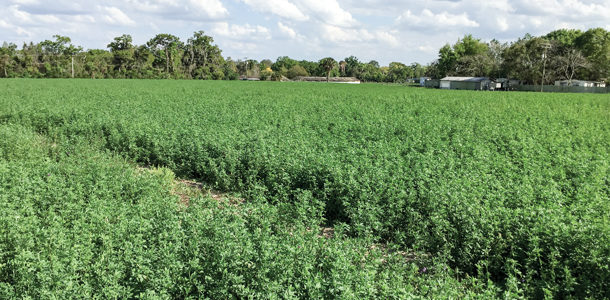However, foliar fertility requirements are quite high for existing finicky strawberry fields, and Hugh MacDonald was looking for a crop that could capitalize on the sandy soils and residual soil nutrients once the strawberries were pulled.
He thought about a cover crop but hated to just till it under, figuring there had to be a way to monetize whatever his rotation was.
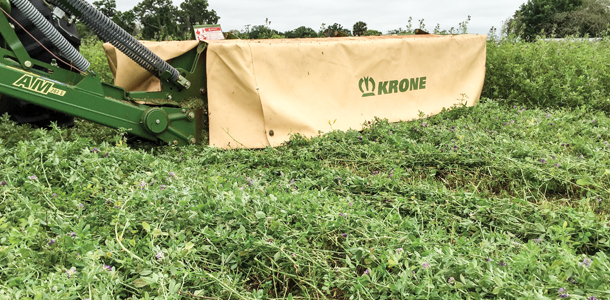 Alfalfa, however, would sell; he knew that. Alfalfa is usually short-lived in Florida and is typically shipped from out of state to meet premium urban horse and thoroughbred markets.
Alfalfa, however, would sell; he knew that. Alfalfa is usually short-lived in Florida and is typically shipped from out of state to meet premium urban horse and thoroughbred markets.
One of the reasons Florida hay was in such high market demand was because it was so difficult to grow, and many Florida warm-season grasses lack protein and are lower-quality compared to the cool-season grasses.
Frequent rainfall would water the crop well enough, and sandy soil would drain alfalfa roots, but getting the hay to dry for baling might require making a deal with the devil himself. And then, of course, there was another small issue: MacDonald had never grown alfalfa before.
But MacDonald wasn’t afraid of trying something new. He says, “A close friend of mine hails from up north and has been in the dairy business all his life. I have watched him over the years buck the Florida norm and do things that a lot of growers here don’t.
In most cases that I am aware of, he has done pretty well. I know one thing is for sure, he has always had the best-looking dairy cattle around, and his milk production was always top-notch. Guys like him inspire me to be different.”
MacDonald researched his options and figured if he could get alfalfa to grow, he might be able to take six cuts off the field. He would then have to figure out how to put up the hay once he figured out how to grow it.
Marketing would be the easy part. It would be a pioneering experiment with a steep learning curve, but MacDonald thought it was worth a shot.
At the same time, Yoana Newman, forage extension specialist with the University of Florida, had been testing alfalfa in central Florida and was working with Brevard County extension agent Joseph Walter on the other side of the peninsula in Cocoa, Florida.
Newman and Walter had some demonstration plots where they were testing alfalfa adaptation to different fertility conditions. While legumes were challenging to grow in Florida, Newman knew it wasn’t impossible, and in sandy soils alfalfa had potential.
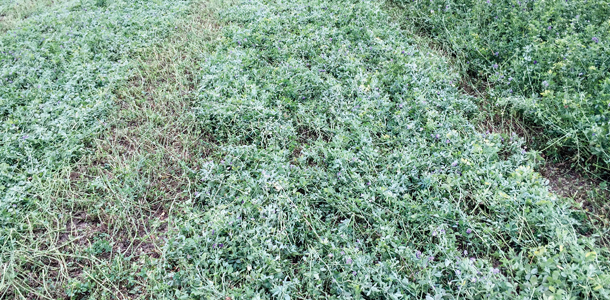 MacDonald and Newman settled on planting Alfagraze 600, a Roundup Ready alfalfa variety, using a Brillion seed drill at 25 pounds per acre.
MacDonald and Newman settled on planting Alfagraze 600, a Roundup Ready alfalfa variety, using a Brillion seed drill at 25 pounds per acre.
He planted on Dec. 20, 2013. Following soil tests, the fields received split-applications of 300 pounds of 0-0-60 and 3 pounds of molybdenum.
And then the emails and text messages flew back and forth as MacDonald and Newman gauged crop progress and tried to anticipate problems.
Challenges
MacDonald initially had trouble with potassium deficiency and soil pH, in a crop that is pH-sensitive. He says, “I planted one field with a pH of 7.9 with the hopes of getting the pH down quickly with high-grade Tiger sulfur, and it did not work fast enough.”
Once he got the pH level adjusted, the fields produced really well. And while alfalfa does not need nitrogen, MacDonald says he found in Florida that it helps to use about 20 pounds per acre to jump-start it. He says this lesson cost him in yield and soil amendments.
During hotter and wetter periods, MacDonald and Newman identified some signs of nutrient deficiency and higher aphid populations.
MacDonald used a foliar application to combat the deficiency but chose not to attack the aphid problem with chemicals. Instead, he managed for shorter plants at harvest. MacDonald says, “This causes the plant to work on building roots and decreases the population of aphids naturally.
This would be the best harvest period in other places, but here the plant has slowed down due to the high heat. Less plant height equates to less moisture transpiration, therefore the plant seems to do better by this practice. When things start cooling off, I fertilize it and let it go.”
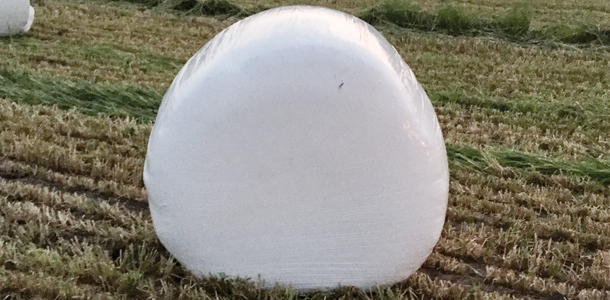 Harvesting in Florida can be touch-and-go for many crops, but alfalfa presented a new set of challenges. Fortunately, for rainy climates like Florida, there are options now to dry hay harvesting or green-chopping, and bales can be wrapped in plastic at higher moistures to produce haylage.
Harvesting in Florida can be touch-and-go for many crops, but alfalfa presented a new set of challenges. Fortunately, for rainy climates like Florida, there are options now to dry hay harvesting or green-chopping, and bales can be wrapped in plastic at higher moistures to produce haylage.
MacDonald says this practice has really opened up the possibilities for alfalfa production in Florida. He was determined to bale what dry hay he could and wrap the rest.
First harvest
The first cutting was taken March 20, 2014. MacDonald was able to get it dry enough to bale with a small baler, and it tested at 22 percent crude protein and 34 percent neutral detergent fiber (NDF). Yield on his first cut was just over 1 ton.
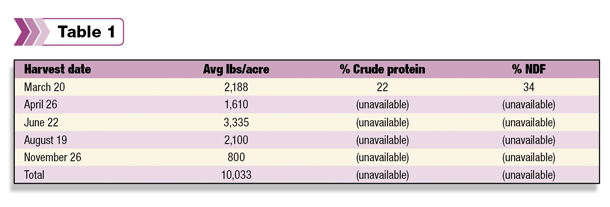
The second cutting, which began April 26, was met with summer rains and couldn’t be baled as dry hay. MacDonald ended up wrapping those bales.
With the third through sixth cuttings, MacDonald tried a hay desiccant, which enabled him to bale within a day-and-a-half and allowed him to take his last cutting Nov. 26.
Planning ahead
After a year of trial and error, MacDonald is now into his second production year.
When asked what adjustments he made based on his experience of the previous year, MacDonald says, “I pray more often. . . . I am doing more tissue and soil sampling to better determine nutrient uptake. I have also purchased some of my own equipment this year to better help with controlling my harvesting.”
MacDonald also found that planting in a poorly drained field wasn’t a good idea. He lost 20 acres due to prolonged rains on that field and has since replanted this field into a more suitable forage. He was, however, able to lease another field that will work better for future alfalfa plantings.
He’s a firm believer that alfalfa can be grown profitably for central and northern Florida. However, land is very valuable in the Tampa region, and he may look at moving the operation further north.
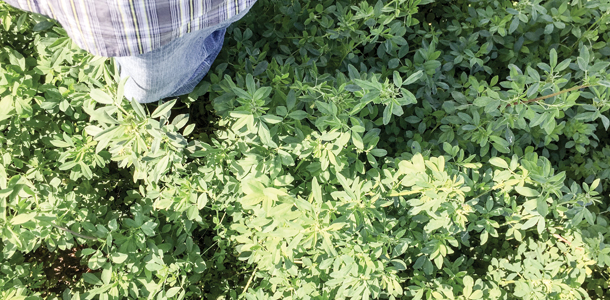
Of his experiment, MacDonald says, “I give God the glory for any headway I have made, and my ability to do this is because He has blessed my family with the means that I have needed and has given the increase in the seed that I planted.
My parents have also been a tremendous support through the years.”
He also readily expresses gratitude to the landowners for believing in him, Leroy Larisey and Richard Green, and especially to Dr. Newman for answering his many texts and emails, and giving constant guidance and support.
After a year of worry and effort, MacDonald is still optimistic and offers this advice for anyone thinking about such an experiment as his.
MacDonald says, “Pray on it. Go for it, but do the soil work first. Be on your A game because it will require a lot of diligence to do it. I highly recommend it for grazing. I would say do it on a small scale for haying and a little bigger for haylage.”
And he perceptively adds, “Watch your potassium levels.” FG
PHOTOS
PHOTO 1: Hugh MacDonald has experimented and found success raising alfalfa in Florida on what was formerly a strawberry field.
PHOTO 2 & 3: MacDonald uses a wide swath to dry hay as quickly as possible.
PHOTO 4: Challenged with humidity, MacDonald found haylage to be a viable alternative to dry hay.
PHOTO 5: MacDonald manages alfalfa harvest for shorter plants during periods of high heat. Photos courtesy of Hugh MacDonald.
